What is a neurosurgical halo vest device?

The neurosurgical halo vest device holds the head and neck in place so the spine can heal after an injury or surgery. The halo is a ring that surrounds the head and is attached by pins to the outer portion of your child's skull. The vest is lined with medical-grade lambswool that is worn on your child's torso. The vest also has plastic straps that can be adjusted by the neurosurgery team. Rods are connected to the vest and extend up to the halo. Your child's halo device will come with an Allen or hex key and wrench. These must always be secured to the front of the vest as they are needed in an emergency. The halo vest device may also be referred to as a "halo vest" or "halo".
How long will my child be in the neurosurgical halo vest device?
Your child's health-care team will determine how long your child will need to be in the halo vest device. The length of time depends on the type of surgery or injury and your child's healing progress. Imaging will be done to monitor the healing process and your child's neurosurgeon will discuss these results with you. Typically, children wear a halo device for a couple of months.
Safety tips for halo vest devices
- Do not adjust the pin sites or the halo vest, this is only to be done by the neurosurgery team.
- Always keep the Allen or hex key and wrench attached to the front of the vest in case of a medical emergency.
- Do not unbuckle both sides of the halo vest at the same time.
- If your child travels in a car seat, make sure the seat is high and wide enough to support a halo.
- Adolescents in halo vest devices should not drive.
- Your child cannot participate in contact sports, vigorous physical activity, gym class, amusement park rides or swimming until cleared by the neurosurgery team.
- Never use any part of the halo vest device to lift or reposition your child.
- Avoid prolonged exposure to extreme hot or cold temperatures because the metal on the halo device can become extremely hot or cold.
Preparing your child to wear a halo vest device
Unless your child has met someone who has been in a halo vest device, there is no way to truly prepare them for what to expect. Many families have said it is helpful to talk to your child and provide them with age-appropriate information. You can explain to your child the halo vest device will feel heavy and it may take a while to get used to it. Make sure your child follows the food and drink guidelines before their surgery. Your neurosurgery team may give you additional instructions to follow.
Overview of the procedure
Your child's health-care team will let you know the approximate time of the procedure. Your child is brought to the operating room and goes to sleep under general anesthesia. Your child will not feel any pain during the operation. The halo ring is attached using pins. Depending on why your child is having the halo device, your child's surgeon will place four to ten pins into the outer layer of their skull. These pins are threaded through the halo ring. The vest that your child will wear is plastic and lined with medical-grade lambswool. There will be metal rods that attach the fitted halo vest to the halo ring. The halo vest device will hold the head and neck still, so the bones can heal.
After surgery
Once the halo vest device has been placed, your child will be brought to an inpatient unit. The health-care team will continue to check your child's condition and progress.
Your child can slowly start to eat and drink once the health-care team clears them to do so. If your child begins to cough while drinking or eating, stop and let your child's nurse know.
Wearing the halo vest device should not be painful for your child. When the halo vest device is first fitted, your child may report some pain at the pin sites or their forehead. This pain may worsen when your child is eating or yawning. Most children get used to the brace and the pain goes away over the first few days. If your child's pain does not go away or is getting worse, contact your neurosurgery team.
Wearing a neurosurgical halo vest device
Your child can begin to mobilize once cleared to do so by the health-care team. The physiotherapy team may be consulted after surgery to help your child begin to move as safely as possible. The added weight of the halo vest device can affect your child's balance and mobility of their upper body.
Helping your child
While your child is wearing the halo vest device, you will need to learn to care for their vest, skin and pin-sites.
Taking care of the halo pin sites at home
Before cleaning your child's pin sites, look at them for signs of scabbing, pin loosening, any clicking noise or any signs of infection such as redness, swelling or drainage. Consider using a flashlight to better see the pin sites. It is important to keep the pin sites clean due to the risk of infection. If you are concerned about any of your child's pin sites, take a photo of the pin site(s) and contact your child's neurosurgery team for further guidance.
Clean the pin sites once a day. You will need a cleaning solution (gentle soap/water or normal saline*) and cotton swabs (e.g., Q-tips).
- Wash your hands.
- Soak a cotton swab with soap and water or normal saline.
- Clean the pin site in a circular motion around the pin, moving from the pin insertion site outward.
- For each pin, pat dry using a separate cotton swab or non-woven gauze.
- Repeat for each pin site using a new cotton swab for each pin site.
* Normal saline can be bought at your local drugstore or made at home. Please see the instructions to make normal saline at home.
Sometimes, a crust can form around the pins. If you are ever unsure if this is a sign of infection, take a photo of the pin site and contact your neurosurgery team. Soak non-woven gauze or a clean face cloth with warm clean water and wrap it around the crusted pin site until the crust has softened enough for easy removal.
In some cases, your neurosurgery team may advise different guidelines on frequency, method and materials. Please follow this advice.
Taking care of the halo vest

The halo vest should be kept dry. Place a towel or absorbent pad against the lambswool to prevent it from getting wet while washing your child. If the lambswool accidentally gets wet, dry it with a hairdryer on a cool setting. Examine your child's halo vest for loose straps, screws, dirt and odour.
Monitor the fit of the vest. You should be able to insert two fingers under your child's vest at the shoulder and chest while your child is lying on their back. Make sure the Allen key and wrench are always secured to the front of the vest as shown below.
Taking care of your child's skin under the vest
Try and keep the skin under your child's vest as dry as possible. Look at your child's skin daily at the edges of the vest and under the vest for any skin irritation, redness or abrasions. Consider using a flashlight to better see under the vest. Encourage your child not to scratch under the vest. Do not use lotions or powders underneath the vest. If your child is reporting pressure points over their shoulders or back, contact your neurosurgery team as the vest may need to be adjusted to avoid skin breakdown.
Bathing your child under the vest
Your child will not be able to sit in a bathtub or be submerged in water while wearing the halo vest device. Wash your child's chest and back daily with soap and water. Take this opportunity to look at your child's skin underneath the vest. Consider using a flashlight to better see the skin. Assess skin for redness, irritation and abrasions, especially over bony areas that stick out. If you have any concerns about skin breakdown, contact your neurosurgery team. Follow these steps to bathe your child:

- Position your child on their side.
- Open the side of the vest strap that is facing up. Note or mark the buckle notches before unbuckling the vest so you remember where to re-buckle the vest.
- Do not release both sides of the straps at the same time. This can loosen the halo device and alter the position of the head and neck.
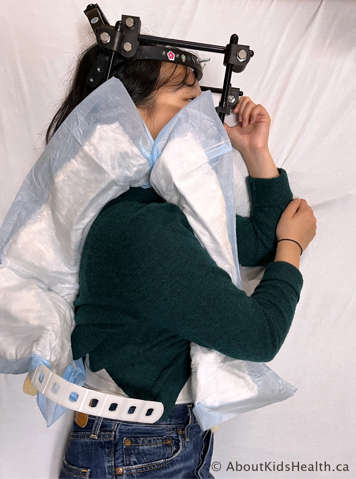
- Place a towel or an absorbent pad inside the halo vest, against the lambswool, to prevent it from getting wet. Wash your child's chest and back with gentle soap and water using a small washcloth.
- Rinse with a water-soaked washcloth.
- Dry skin thoroughly and secure the vest by closing the open strap.
- Turn your child to the other side and repeat the steps above.
Washing your child's hair
If your child is cooperative and strong enough to support their head and the weight of the halo vest device, they may lean over the side of a bathtub to wash their hair.
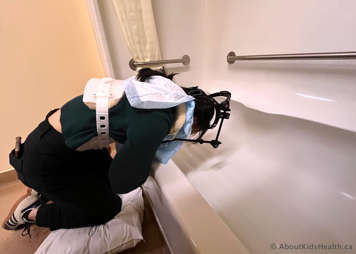
- Make sure your child's head is positioned lower than their shoulders, so the water runs off them into the tub instead of into the vest.
- Insert thin towels or absorbent pads around the shoulders of the vest to prevent the vest from getting wet.
- Place a pillow beneath your child's knees for comfort.
- Gently wet their hair, wash and rinse as usual.
If your child is unable to lean over the side of the bathtub, a hair wash can be done with your child lying in bed.

- Your child should be lying flat on their back with their head suspended beyond the top of the mattress. Their shoulders should still be on the mattress.
- Place thin towels or absorbent pads along the back and shoulders of the halo vest device to protect the lambswool from getting wet.
- Place a garbage can or a large basin under your child's head to catch the water. Consider placing a plastic sheet under your child's shoulders and into the garbage can or basin as an additional precaution to catch the water.
- Gently wet their hair, wash and rinse as usual.
A gentle, mild, non-scented shampoo or soap is safe to use around pin sites. Be careful not to apply the shower head directly onto the pin sites. Consider using a cup or small basin to add water to your child's hair. No hair dyes, perms, scented products, dry shampoo or other hair products should be used while your child has a halo vest device.
What to wear with a halo vest device
There are various ways to dress your child with a halo vest device. You can dress your child in a button-up shirt that can be worn over the vest. You can also dress your child in a tank top or loose-fitting shirt that can slide up underneath the halo vest device from below the waist. Do not put bulky clothing underneath your child's halo vest device as it can affect the alignment of the halo vest device. Some families have found it helpful to modify clothing to fit around the halo vest device. Clothing with snaps, buttons or zippers may be helpful during this time. Slip-on shoes will be the easiest for your child to wear. Make sure the shoes have good support and rubber soles.
Activities and mobility with a halo vest device
Many children with halo vest devices will eventually be able to continue their basic everyday activities such as walking, going to school, studying and spending time with friends if they feel well enough to do so. Your child's balance, center of gravity and coordination will be affected by the halo vest device. Encourage your child to move slowly and turn their head and upper body slowly as they are at higher risk of falling with the halo vest device. At home, try to clear as many tripping hazards as possible to help prevent falls as your child will not be able to look down as easily. Also, encourage your child to use the railing and walk slowly while going up and down stairs. Your child may require a mobility aid such as a walker while walking. Some children may not be able to walk due to the weight of the halo vest device. Your child should avoid heavy lifting including heavy toys or heavy backpacks. Your child cannot participate in contact sports, vigorous physical activity, gym class, amusement park rides or swimming until cleared by the neurosurgery team.
How to eat in the halo vest device
It is important to eat sitting upright. Place a towel or absorbent pad around the neck of the vest to avoid getting the vest's lambswool dirty. Encourage your child to take smaller bites and chew food thoroughly. A straw will make drinking easier, as your child will not be able to tilt their head back. Monitor your child for signs of difficulty swallowing. If your child is having difficulty swallowing, alert the neurosurgery team and seek medical attention.
How to sleep in the halo vest device
Your child may sleep in any position in the halo vest device that is comfortable for them. A small, rolled-up towel or foam wedge can be used between your child's head or ear and the surface of the bed for comfort. Your child will need assistance with rolling and getting out of bed. When getting out of bed, encourage your child not to sit upright by bending at their waist as it puts a lot of pressure on the halo vest device. Help your child to roll onto their side and drop their legs over the side of the bed. Either with your assistance or independently, your child can use their elbow and hand to push sideways to sit up.
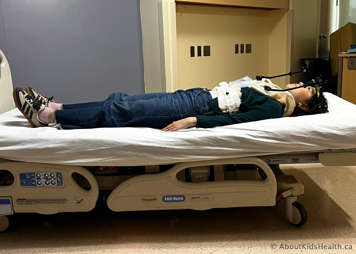
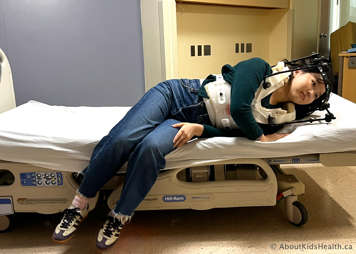

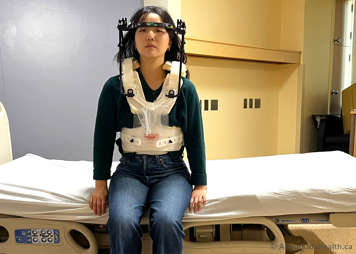
How to travel in a car with the halo vest device
You should avoid travelling long distances while your child is in the halo vest device in case the need for medical attention arises. Long car rides also should be avoided as your child may become more easily tired.
If your child needs a car seat to safely travel, their health-care team will help make sure you have a safe way to transport them with the halo vest device.
Coping with a halo vest device outside of the home
Reading and writing will be challenging as your child will not be able to turn their head. Explain the situation to your child's school and teachers ahead of time. Ask if your child can keep a separate set of books at school to lessen the burden of carrying a heavy bag to and from school. Some families may opt to do school from home or virtually.
Being in a halo device can feel frustrating since there are several things your child will not be able to do independently while the halo vest device is on. Your child may also feel self-conscious about the halo vest device. Remind your child that this device is essential in helping them heal and return to their normal activities. Prepare your child for the questions that other people may have. Explain to your child that these questions stem from curiosity and to try not to let it bother them. Be calm and encouraging. Remind your child that some everyday tasks may be more complicated than before, but there are ways to still do them, just a little differently. For example, your child may still hug others but doing so from the side rather than facing them.
Neurosurgery follow-up
Your child's neurosurgery team will contact you to arrange a follow-up appointment in the Neurosurgery clinic. Please refer to your child's After Visit Summary given to you at discharge from the hospital regarding the timeline for this appointment. They will assess your child's symptoms, pin sites and overall fit of the halo device.
Removal of the halo vest device
Removal of your child's halo vest device is done under general anesthesia or sedation. There will be small wounds on your child's head from where the pins were removed. Dressings may be applied immediately after pin removal; however, these areas should scab over within 24 to 48 hours. Your child's old pin sites should be kept dry for 24 hours after halo removal. After this, your child can bathe normally. A dressing is no longer needed once the pin sites scab over.
After the halo vest device is taken off, your child might be required to wear a cervical collar, as advised by their surgeon. The collar provides extra safeguarding against excessive strain on the neck and helps ease back into their regular activities. Please refer to AboutKidsHealth collar care page for more information.
When to seek medical attention
Contact your child’s health-care provider or neurosurgery team if they:
- show any signs of infection
- Increased pain, swelling, warmth, redness, drainage or scabbing at pin sites
- Fever
- have worsening or new skin breakdown
- have increasing pain and pain medications are not helping
- have new dizziness
- have had a fall
- have pain where the vest might be putting too much pressure on their body or any other signs of inadequate vest fit
- have a pin or any part of the brace that seems loose or out of place
- can nod their head
- have difficulty swallowing
Call 911 or take your child to the nearest emergency department if they have:
- new tingling or numbness
- new weakness in their arms or legs
At SickKids
Please refer to the After Visit Summary for how to contact your child's neurosurgery team. You may call the Neurosurgery clinic at 416-813-5222.